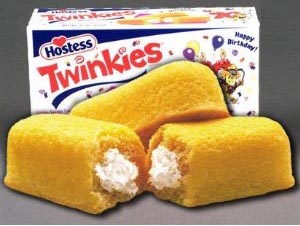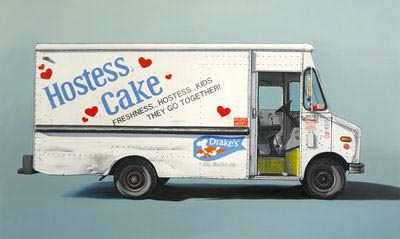 I went to a small grade school in rural Nebraska (there were 7 in my class) and I can remember vividly the day whispers started to circulate with unusual excitement. It was the day a classmate came back into our combined seventh and eighth grade class one sunny mid-afternoon with the news that most kids only dream of: a Hostess truck had hit some loose gravel and tipped over into the ditch outside of town spilling everything into the grass. When the bell rang, my buddy Bob and I were the first to the site. Expecting to find only remnants, we instead found lots of intact packages of Twinkies and cupcakes left behind. Easy pickin’s and FREE! What more could a kid want? I became an instant fan of Twinkies. Unfortunately, I couldn’t afford to actually buy them so I was always waiting for another truck to tip over.
I went to a small grade school in rural Nebraska (there were 7 in my class) and I can remember vividly the day whispers started to circulate with unusual excitement. It was the day a classmate came back into our combined seventh and eighth grade class one sunny mid-afternoon with the news that most kids only dream of: a Hostess truck had hit some loose gravel and tipped over into the ditch outside of town spilling everything into the grass. When the bell rang, my buddy Bob and I were the first to the site. Expecting to find only remnants, we instead found lots of intact packages of Twinkies and cupcakes left behind. Easy pickin’s and FREE! What more could a kid want? I became an instant fan of Twinkies. Unfortunately, I couldn’t afford to actually buy them so I was always waiting for another truck to tip over.
The definition of customer value can be put into an equation: Customer Value = (Quality Product + Other Benefits)/(Price + Other Costs). A huge cache of Twinkies only cost me a quick sprint down the street (i.e., low cost to me). The Twinkie Spill of ‘67 delivered very high “Customer Value”.
The Twinkie Spill teaches three lessons about value:
 over. This is a real problem since successful business models require you to create economic value too. There are products out there that are sold on price promotion almost all the time. In most cases, it’s a way to buy revenue, manage price elasticities or hold share in an over commoditized marketplace. In too many product categories, selling has become promotion-dependent. Customers have learned to wait for the Twinkie Spill Strategy.
over. This is a real problem since successful business models require you to create economic value too. There are products out there that are sold on price promotion almost all the time. In most cases, it’s a way to buy revenue, manage price elasticities or hold share in an over commoditized marketplace. In too many product categories, selling has become promotion-dependent. Customers have learned to wait for the Twinkie Spill Strategy.A tension always exists in business models between the need to increase customer value (usually by improving quality, adding benefits or reducing price) and the need to increase economic value (usually by pricing up or cutting costs). Companies need strategic focus, innovation, and thoughtful design when it comes to business models in order to manage this tension. Otherwise, they will likely squander the margin between customer and economic value. Of course, if economic value isn’t important you can always create your own Twinkie spill. That was the best day of 7th grade by far.